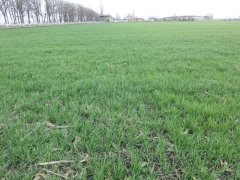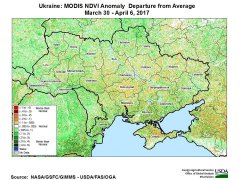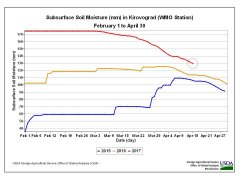Ukraine: Early Spring Conditions for 2017/18 Winter Wheat
In late March and early April, personnel from the USDA Foreign Agricultural Service (FAS) conducted field travel in Ukraine. The team examined 2017/18 winter-crop conditions in key production territories, interviewed farm directors, agricultural officials, private commodity analysts, and visited a hybrid seed production facility. Winter crops were observed to be in generally good condition although spring development was slightly behind average due to late planting and delayed fall establishment.
 Farmers interviewed by the FAS team reported that the sowing campaign for 2017/18 winter grains was delayed by several weeks due to persistent dryness during September and October. The late planting shortened the time available for crop establishment and fall tillering. Winter grains in some fields entered dormancy with only one to three tillers rather than the optimum five, and crops in some fields had not yet emerged when winter arrived. The farmers’ descriptions were consistent with data from the Ministry of Agrarian Policy and Food of Ukraine, which cited that as of February 9 winter grains had not yet emerged on 5 percent of the planted area. Winter wheat is Ukraine’s chief winter crop, accounting for about 75 percent of the country’s total winter crop area and for nearly 98 percent of Ukraine’s total wheat output. Farmers interviewed by the FAS team reported that the sowing campaign for 2017/18 winter grains was delayed by several weeks due to persistent dryness during September and October. The late planting shortened the time available for crop establishment and fall tillering. Winter grains in some fields entered dormancy with only one to three tillers rather than the optimum five, and crops in some fields had not yet emerged when winter arrived. The farmers’ descriptions were consistent with data from the Ministry of Agrarian Policy and Food of Ukraine, which cited that as of February 9 winter grains had not yet emerged on 5 percent of the planted area. Winter wheat is Ukraine’s chief winter crop, accounting for about 75 percent of the country’s total winter crop area and for nearly 98 percent of Ukraine’s total wheat output.
 Farmers also described above-average snow accumulation during the winter, which benefited crops in two ways. The snow cover protected winter crops against frost damage and the melting snow replenished the depleted subsurface soil moisture. The high soil moisture enabled non-emerged winter crops to eventually germinate and sprout. The FAS team observed that winter crop fields were in outstanding condition in terms of emergence and establishment. The team saw virtually no evidence of crop-emergence failures or winter damage. A discussion with an official at the State Statistical Committee in Kyiv confirmed analysts’ observations; winterkill this year is forecast to be negligible. Due to the abbreviated vegetative period in the fall, development was slightly behind average when grains entered winter dormancy, but above-average temperatures in early March enabled crops to resume vegetative growth earlier than usual. Farmers also described above-average snow accumulation during the winter, which benefited crops in two ways. The snow cover protected winter crops against frost damage and the melting snow replenished the depleted subsurface soil moisture. The high soil moisture enabled non-emerged winter crops to eventually germinate and sprout. The FAS team observed that winter crop fields were in outstanding condition in terms of emergence and establishment. The team saw virtually no evidence of crop-emergence failures or winter damage. A discussion with an official at the State Statistical Committee in Kyiv confirmed analysts’ observations; winterkill this year is forecast to be negligible. Due to the abbreviated vegetative period in the fall, development was slightly behind average when grains entered winter dormancy, but above-average temperatures in early March enabled crops to resume vegetative growth earlier than usual.
Farmers in most areas described crop conditions as roughly similar to last year. Satellite-derived vegetative indices (normalized difference vegetative indices, or NDVI) from early April are generally consistent with farmers’ assessments of winter-crop development. The NDVI indicate that crop vigor is better than average in some territories and slightly worse than normal in others. Conditions are similar to those for 2016/17 winter grains, when persistent fall dryness also hampered fall establishment. Delayed early-spring development, however, does not necessarily portend low yield. Last year, final wheat yield reached record levels in most territories in Ukraine. As of mid-April, winter grains were in the tillering stage throughout Ukraine.
 The team observed the planting of spring barley, and plants were beginning to emerge in southern Ukraine. The planting of sunflowers was just underway, but corn and soybean planting had not yet begun at the time of the crop assessment tour. As of April 18, according to data from the Ukraine Ministry of Agrarian Policy and Food, barley planting was 94 percent complete, sunflower planting was 24 percent complete, and corn and soy planting had only recently begun. The team observed the planting of spring barley, and plants were beginning to emerge in southern Ukraine. The planting of sunflowers was just underway, but corn and soybean planting had not yet begun at the time of the crop assessment tour. As of April 18, according to data from the Ukraine Ministry of Agrarian Policy and Food, barley planting was 94 percent complete, sunflower planting was 24 percent complete, and corn and soy planting had only recently begun.
Although surface moisture was becoming depleted in south-central Ukraine following relatively low precipitation since January, timely precipitation in early April boosted topsoil moisture for vegetative winter crops and improved conditions for the planting and emergence of spring crops. Moreover, subsurface moisture remains high in most areas, resulting from the melting of the deep snow cover. As usual, crops will require additional precipitation during the growing season and final yield will depend to a large degree on the weather throughout the remainder of the growing season.
The valuable contribution of Denys Sobolev, Agricultural Specialist at the Office of Agricultural Affairs in Kyiv, to the preparation of this report is gratefully acknowledged. The initial USDA estimates for global 2017/18 crop production will be released on May 10, 2017.
Current USDA area and production estimates for grains and other agricultural commodities are available on IPAD's Agricultural Production page or at PSD Online.
Visit Crop Explorer http://www.pecad.fas.usda.gov/cropexplorer/
|

